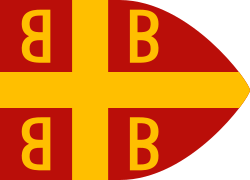ចក្រភពប៊ីហ្សីនទីន [note ១] ត្រូវបានគេសំដៅផងដែរថាជា ចក្រភពរ៉ូម៉ាំងខាងកើត ឬ ប៊ីហ្សានទីម គឺជាការបន្តនៃចក្រភពរ៉ូម នៅក្នុងខេត្តភាគខាងកើតរបស់ខ្លួនក្នុងកំឡុង សម័យបុរាណចុង និង យុគសម័យកណ្តាល នៅពេលដែលរដ្ឋធានីរបស់វាគឺខនស្ទែនទីណូបែល ។ វាបានរស់រានមានជីវិតពីការបែកបាក់ និង ការដួលរលំនៃចក្រភពរ៉ូមខាងលិច នៅសតវត្សទី ៥ នៃគ.ស ហើយបន្តមានរាប់ពាន់ឆ្នាំបន្ថែមទៀតរហូតដល់ការដួលរលំនៃខនស្ទែនទីណូបែល ទៅចក្រភពអូតូម៉ង់ ក្នុងឆ្នាំ១៤៥៣ ។ ក្នុងអំឡុងពេលភាគច្រើននៃអត្ថិភាពរបស់វា ចក្រភពនៅតែជាកម្លាំងសេដ្ឋកិច្ច វប្បធម៌ និងយោធាដ៏មានឥទ្ធិពលបំផុតនៅទ្វីបអឺរ៉ុប ។ ពាក្យ "ចក្រភពប៊ីហ្សីនទីន" និង "ចក្រភពរ៉ូមខាងកើត" ត្រូវបានបង្កើតឡើងបន្ទាប់ពីការបញ្ចប់នៃអាណាចក្រ។ ប្រជាជនរបស់ខ្លួនបានបន្តសំដៅទៅលើចក្រភពរបស់ពួកគេថាជា ចក្រភពរ៉ូម ហើយចំពោះខ្លួនពួកគេថាជាជនជាតិរ៉ូម [note ២] ដែលជាពាក្យដែលក្រិកបានបន្តប្រើសម្រាប់ខ្លួនគេក្នុងសម័យអូតូម៉ង់។ ទោះបីជារដ្ឋរ៉ូម៉ាំងបានបន្ត និងប្រពៃណីរបស់វាត្រូវបានរក្សាក៏ដោយ អ្នកប្រវត្តិសាស្រ្តសម័យទំនើបបានបែងចែកប៊ីហ្សីនទីនពីការចាប់កំណើតមុនរបស់វា ព្រោះវាផ្តោតលើខនស្ទែនទីណូបែល តម្រង់ឆ្ពោះទៅរកភាសាក្រិចជាជាងវប្បធម៌ឡាតាំង និងកំណត់លក្ខណៈដោយ គ្រិស្តអូស្សូដក់ខាងកើត ។
ព័ត៌មានសង្ខេប ស្ថានភាព, ធានី ...
ចក្រភពប៊ីហ្សីនទីន Βασιλεία Ῥωμαίων (Ancient Greek)a
Imperium Romanum (Latin) |
|---|
| 330/395–1453b |
|
Imperial banner of the late-Byzantine Palaiologos dynasty |
 The empire in 555 under Justinian the Great, at its greatest extent since the fall of the Western Roman Empire (its vassals in pink) |
 |
| ស្ថានភាព | {{#if: | | |
|---|
| ធានី | Constantinople (modern-day Istanbul)c |
|---|
| ភាសាទូទៅ |
- Greek[៣]
- Latin
- Regional / local languages
|
|---|
| សាសនា |
- Roman polytheism (former)
- Greek paganism (former)
- Eastern Christianityd
- Eastern Orthodoxye
- Minority: Islam and Judaism
|
|---|
| រដ្ឋាភិបាល |
|---|
- | 15 August 1461 |
|---|
| 11 May 330 |
- Final East–West division after the death of Theodosius I | 17 January 395 |
|---|
- Assassination of
Julius Nepos | 9 May 480 |
|---|
- Early Muslim conquests; start of the Dark Ages | 634–750 |
|---|
- Battle of Manzikert; loss of Anatolia due to following civil war | 26 August 1071 |
|---|
- Sack of Constantinople by Catholic crusaders | 12 April 1204 |
|---|
- Reconquest of Constantinople | 25 July 1261 |
|---|
- Fall of Constantinople | 29 May 1453 |
|---|
| ប្រជាជន |
|---|
|
▪ 457 | 16,000,000f |
|---|
▪ 565 | 26,000,000 |
|---|
▪ 775 | 7,000,000 |
|---|
▪ 1025 | 12,000,000 |
|---|
▪ 1320 | 2,000,000 |
|---|
|
|
| រូបិយវត្ថុ | Solidus, denarius and hyperpyron |
|---|
| Preceded by | Succeeded by |
|
|
| Ottoman Empire |
 |
|
|
- ^ Βασιλεία Ῥωμαίων may be transliterated in Latin as Basileia Rhōmaiōn, literally meaning "Monarchy of the Romans", but commonly rendered "Empire of the Romans".
- ^ Between 1204 and 1261 there was an interregnum when the Latin Empire took control of Constantinople, causing the Byzantine Empire itself to be divided into the Empire of Nicaea, the Empire of Trebizond, and the Despotate of Epirus. The Empire of Nicaea is considered by historians to be the legitimate continuation of the Byzantine Empire because it managed to retake Constantinople.
- ^ Constantinople became the capital of the (united) empire in 330. In 395, the empire was permanently divided in two halves after the death of Theodosius I.
- ^ Tolerated after the Edicts of Serdica (311) and Milan (313); state religion after 380.
- ^ Following the East–West Schism of 1054.
- ^ See Population of the Byzantine Empire for more detailed figures taken provided by McEvedy and Jones, Atlas of World Population History, 1978, as well as Angeliki E. Laiou, The Economic History of Byzantium, 2002.
|
បិទ



